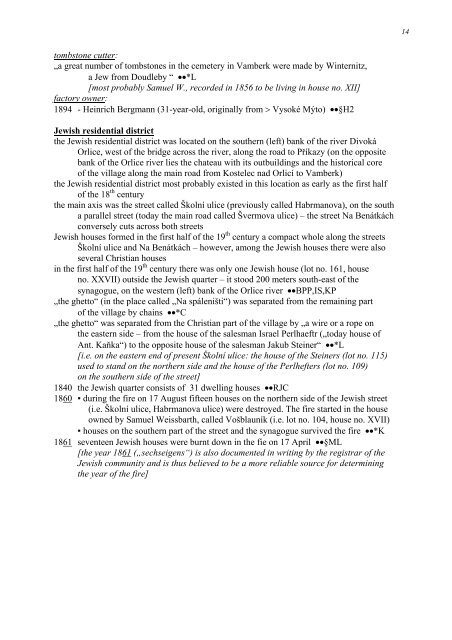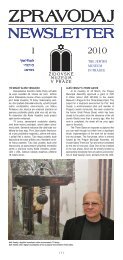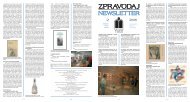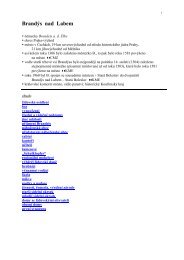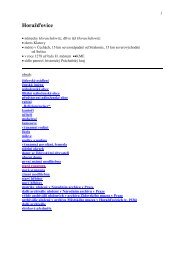Doudleby nad Orlicà - Židovské muzeum v Praze
Doudleby nad Orlicà - Židovské muzeum v Praze
Doudleby nad Orlicà - Židovské muzeum v Praze
Create successful ePaper yourself
Turn your PDF publications into a flip-book with our unique Google optimized e-Paper software.
14<br />
tombstone cutter:<br />
„a great number of tombstones in the cemetery in Vamberk were made by Winternitz,<br />
a Jew from <strong>Doudleby</strong> “ ••*L<br />
[most probably Samuel W., recorded in 1856 to be living in house no. XII]<br />
factory owner:<br />
1894 - Heinrich Bergmann (31-year-old, originally from > Vysoké Mýto) ••§H2<br />
Jewish residential district<br />
the Jewish residential district was located on the southern (left) bank of the river Divoká<br />
Orlice, west of the bridge across the river, along the road to Příkazy (on the opposite<br />
bank of the Orlice river lies the chateau with its outbuildings and the historical core<br />
of the village along the main road from Kostelec <strong>nad</strong> Orlicí to Vamberk)<br />
the Jewish residential district most probably existed in this location as early as the first half<br />
of the 18 th century<br />
the main axis was the street called Školní ulice (previously called Habrmanova), on the south<br />
a parallel street (today the main road called Švermova ulice) – the street Na Benátkách<br />
conversely cuts across both streets<br />
Jewish houses formed in the first half of the 19 th century a compact whole along the streets<br />
Školní ulice and Na Benátkách – however, among the Jewish houses there were also<br />
several Christian houses<br />
in the first half of the 19 th century there was only one Jewish house (lot no. 161, house<br />
no. XXVII) outside the Jewish quarter – it stood 200 meters south-east of the<br />
synagogue, on the western (left) bank of the Orlice river ••BPP,IS,KP<br />
„the ghetto“ (in the place called „Na spáleništi“) was separated from the remaining part<br />
of the village by chains ••*C<br />
„the ghetto“ was separated from the Christian part of the village by „a wire or a rope on<br />
the eastern side – from the house of the salesman Israel Perlhaeftr („today house of<br />
Ant. Kaňka“) to the opposite house of the salesman Jakub Steiner“ ••*L<br />
[i.e. on the eastern end of present Školní ulice: the house of the Steiners (lot no. 115)<br />
used to stand on the northern side and the house of the Perlhefters (lot no. 109)<br />
on the southern side of the street]<br />
1840 the Jewish quarter consists of 31 dwelling houses ••RJC<br />
1860 ▪ during the fire on 17 August fifteen houses on the northern side of the Jewish street<br />
(i.e. Školní ulice, Habrmanova ulice) were destroyed. The fire started in the house<br />
owned by Samuel Weissbarth, called Vošblauník (i.e. lot no. 104, house no. XVII)<br />
▪ houses on the southern part of the street and the synagogue survived the fire ••*K<br />
1861 seventeen Jewish houses were burnt down in the fie on 17 April ••§ML<br />
[the year 1861 („sechseigens“) is also documented in writing by the registrar of the<br />
Jewish community and is thus believed to be a more reliable source for determining<br />
the year of the fire]


